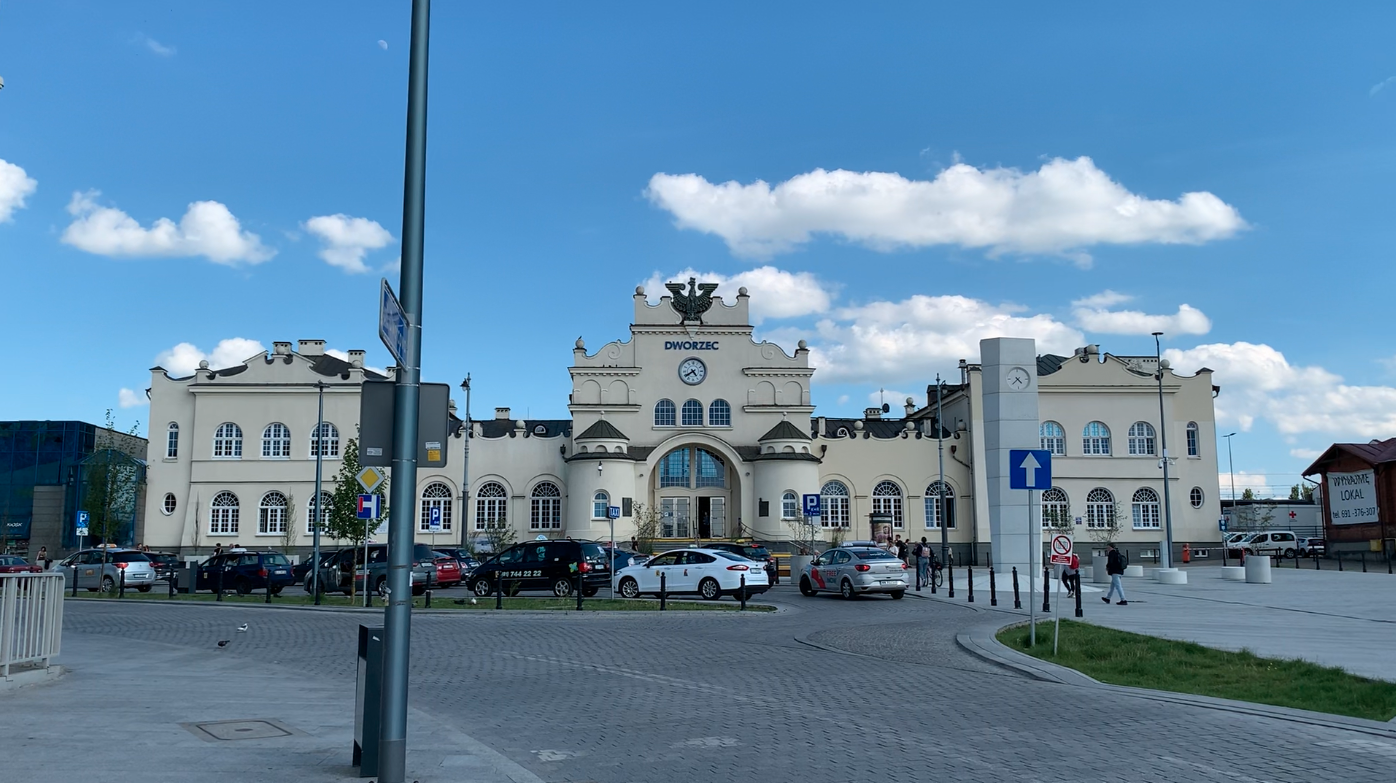Lublin Główny railway station.
Geographical coordinates; 51.228 N 22.562E. Elevation 173 m (567.59 ft). Address: Plac Dworcowy 1, 20-408 Lublin.
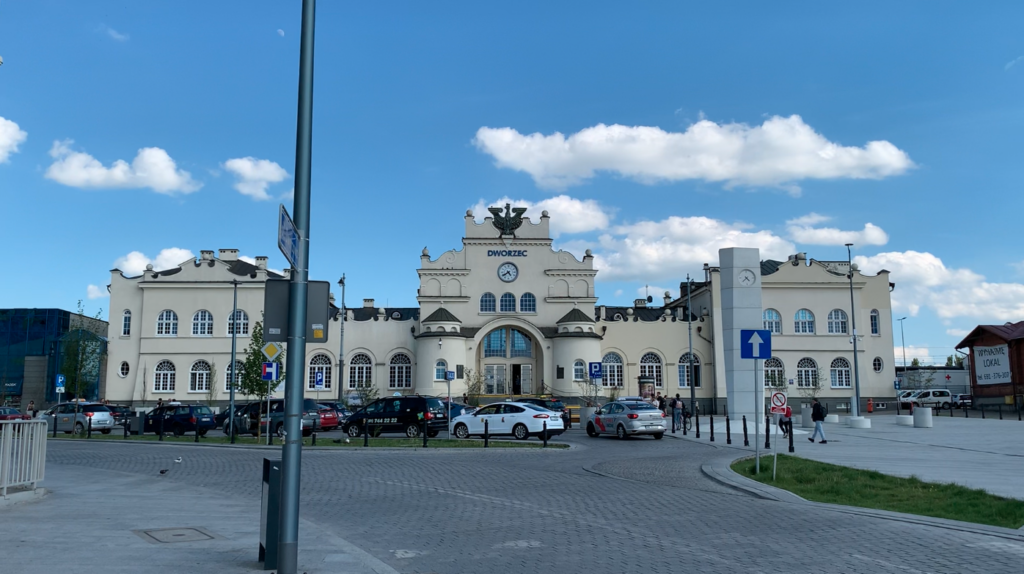
City of Lublin.
The settlement of Lublin was founded in the 6th century, on a trade route; Black Sea – Baltic Sea. Lublin historically belongs to Lesser Poland. In the 10th-15th century, contacts with Sandomierz, which was the center of Northern Lesser Poland, played an important role. Lublin was granted city rights on August 15, 1317. As a result of the Third Partition of Poland, Lublin found itself in the Austro-Hungarian partition. Then the city was in the Duchy of Warsaw, and later in the Kingdom of Poland. The construction of the Vistula Railway played an important role in the development of Lublin.
The current area of the city of Lublin is 147.45 km 2. The city’s population is 331,243 inhabitants (2023), which gives it eighth place in Poland. Distance from Lublin to the cities: Zamość is 86 km, Dorohusk is 95 km, Sandomierz is 114 km, Radom is 114 km, Warsaw is 170 km, Rzeszów is 177 km, Kraków is 334 km. Lublin is the capital of the Lublin Voivodeship and is located in eastern Poland. The border with Ukraine is 95 km away.
The Vistula Railway.
The Vistula Railway is a historic railway line in Poland, built in the second half of the 19th century, i.e. during the Partition of Poland. The Vistula railway line played an important role in the development of transport in the macro region. The Vistula Railway was launched in 1877 and was one of the key railway investments in the territories of the Kingdom of Poland under the Muscovite partition. The main purpose of the line was military transport between forts; Dęblin, Warsaw and Modlin with the fortresses of Volhynia. During the partition period, the line had strategic military and logistical importance, facilitating the movement of troops and equipment. Secondly, the line was to improve transport connections in the region and enable more efficient transport of goods and passengers.
When writing Warsaw, we mean Prague, and currently it is the Warszawa Wschodnia Osobowa station.
Initially, the line connected Mława with Kowel, passing through cities such as; Warsaw, Dęblin, Lublin, Chełm, Rejowiec and Włodawa. What’s more, the Iwanogród (Dęblin) station was a junction station from the very beginning. Later, the route was extended and modified to include branch lines. The line enabled the transport of agricultural products, raw materials and industrial goods. The line was equipped with the infrastructure necessary to handle large freight and passenger flows, including stations, depots, sidings, water towers, locomotive sheds, warehouses and bridges. This route was complemented by a branch from Dęblin to Brest-Litovsk running through Łuków and the Lublin – Łuków route.
Initially, the Vistula Railway was built according to the Moscow broad-gauge standard (1,524 mm), but later part of the line was converted to the European standard-gauge standard (1,435 mm). During the Great World War and the front was moving east, the Germans rebuilt the track to a normal width. At the end of World War II, the Muscovites tried to make the tracks wide again.
In the interwar period and after World War II, the line was modernized and transformed many times to meet the growing transport needs. First of all, electrification with 3 kV DC was carried out on the entire section, which is currently in Poland.
Nowadays, the route of the former Vistula Railway is an important element of the Polish railway network, although it operates under other names and is managed by modern railway companies. Modernizations of railway infrastructure, including electrification and automation, have improved the efficiency and comfort of travel on these routes. The Vistula Railway was therefore a key project that contributed to the economic and infrastructural development of the regions through which it ran, and its legacy is still visible in the Polish railway system.
Lublin railway junction.
Thanks to the railway, Lublin quickly grew and acquired an industrial character. Its urban shape has also changed. During the Great World War and World War II, Lublin was a victim of the predatory economy of all the occupiers, especially the Germans and Muscovites.
Both during the Second Polish Republic and after World War II, Lublin developed dynamically. In the 1950s and 1960s, the number of inhabitants increased threefold. Lublin became an important center of higher education, a number of workplaces and new housing estates were built. The city of Lublin developed as a center of science, culture, tourism, sports, recreation, services and industry. In 2012, Lublin Airport was launched. In recent years, Lublin has received good road connections thanks to the S19 expressway; Via Carpatia named after the President of the Republic of Poland Lech Kaczyński and the S17 Expressway. Next to the Lublin Główny railway station, a new large bus station will be opened in 2024.
In the period 1877-1916, the railway station was called Lublin, but written in Cyrillic Люблин. In the period 1916-2019, the station was named Lublin, and from 2019, it was named Lublin Główny. The Lublin Główny station is named after the “Lublin July 1980”, which recalls the fight of workers and the Polish nation against the communists. In 1974, the Lublin Railway Station was entered into the Provincial Register of Monuments under number 81. The building was last renovated in the period 1996-2004.
According to the PKP classification, the Lublin Główny station has the highest Premium category. The station is located south of the Old Town, at Dworcowy Square, on the border of the districts; Behind the Sugar Factory and Tenth Street. At the station there is the Lublin 2 Post Office and a new bus station. Next to the bus station there is a plot of land where private bus stops were temporarily located. A shopping mall will probably be built in this area. The first decisions were made in February 2024. The investment is to include, among others, plots at the intersection of streets; Stadionowa and Lublin Lipiec ’80.
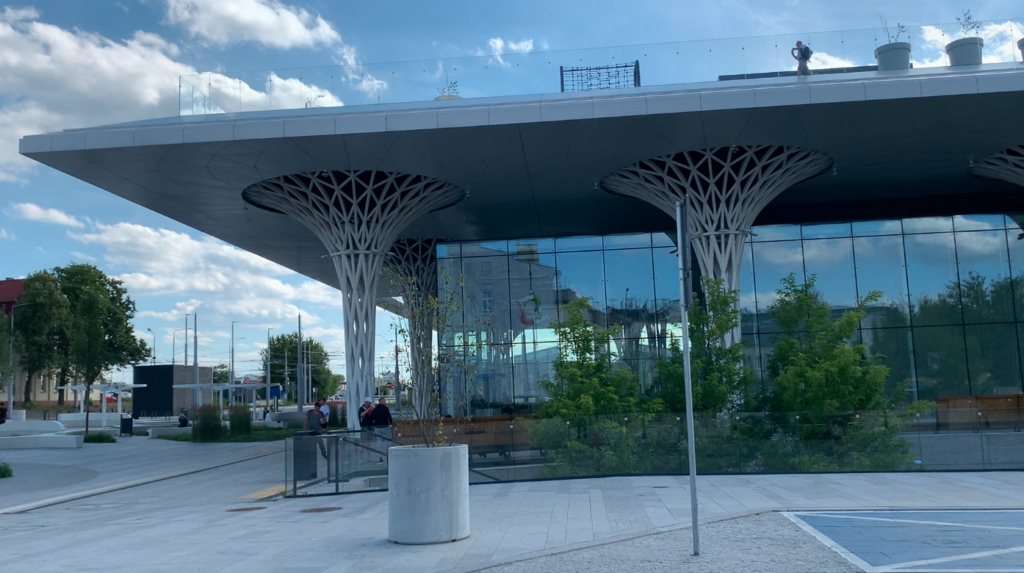
There is a characteristic red brick building at the station square, located between the railway station and the new bus station. Address Apteka 20-406 Lublin ul. Gazowa 2. The building was built at the end of the 19th century as a department store. Then there was a pharmacy there. Currently (2024 year) the building is not in use.
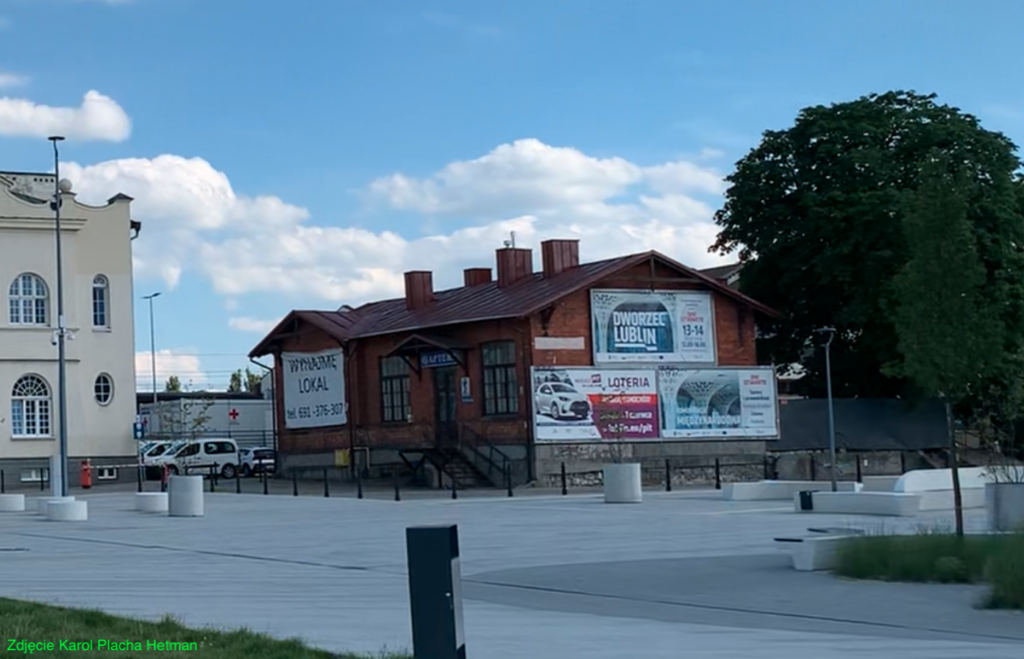
Lublin Główny station serves 1,825,000 passengers per year (data from 2021). The following railway sections are located in Lublin: Przewozy Regionalne, PKP InterCity and PKP Cargo.
History of the Lublin Główny railway station.
The discussion regarding the location of the railway station in Lublin lasted over 10 years. This was mainly due to the administrative machinery of the Moscow state, but also to the disputes of local manufacturers. Basically, two locations were considered. One on the northern side of the city, near the village of Ponikwoda. The second location is on the southern side of the city, in the Za Cukrownią and Bronowice district, or more precisely in the area of the historic settlement of Piaski and the settlement (farm) of Bronowice. Piaski is located directly in the Bystrzyca Valley. Sand and peat were obtained here. The historical center of the Piaski settlement was located at the junction of the Bystrzyca and Czerniejówka rivers, on a flat plain made of river sands. Osada Piaski aspired to be a town.
In 1863, during the meeting of the Governorate Government in Lublin, Gubernia engineer Feliks Bieczyński presented arguments for locating the station south of the city, on the lands of Piaski and Bronowice. The Piaski district had the initial features of a small town, and the area where the station was built was its market square. This area was appreciated as a part of the natural corridor for the construction of the Warsaw – Kowel railway (Vistula Railway). The Lublin Governorate existed in the period 1837-1915.
This area was suitable for founding new industrial plants. The first plants were established here earlier, before the railway line was built. One of them was the Machine Factory and Iron Foundry, founded in 1874 by Mieczysław Wolski and Mieczysław Łabęcki. The factory was located between 1 Maja Street, formerly called Foksal Street, and Wolska Street. Iron castings were produced here, and on their basis modern agricultural machines were manufactured, including; treadmills, threshers and forage harvesters. It was a large factory complex that was nationalized after World War II.
Near the Czerniejówka River, in 1874, a tannery of the Domański brothers was also founded. After World War II, the Lubelskie Zakłady Przemysłu Skórzanego was established on the basis of its facilities, which were then transformed into an enterprise called “Protektor”. An element of this complex is the palace of the former owners, preserved to this day in good condition, standing at 24 Władysława Kunicki Street, formerly Bychawska Street.
In 1899, another factory with an agricultural production profile was founded. It was the Agricultural Machinery Factory and Iron Foundry owned by Robert Moritz. In 1947, the factory was nationalized and merged with M. Wolski’s plants into one large plant, called Lubelska Fabryka Maszyn Rolniczej. In 1991, production was moved to new facilities in the Wrotków district, and the company was transformed into a joint-stock company “SIPMA”.
Also in Bronowice, between the railway line and the road towards Zamość, another machinery factory was founded, which went down in history as the First Polish Aircraft Factory. The factory was founded by Emil Plage and Teofil Laśkiewicz in 1899. Initially, it produced equipment for breweries, distilleries and starch factories. Then the production profile was expanded to include steam boilers for ships. Aircraft production began in 1920 and lasted until 1939, and in 1935 the factory was nationalized. There was a grass airfield next to the factory. During the German occupation, the factory was transformed into a sorting room for looted items from Polish citizens. After the war, the Lublin Car Repair Plant was established on the basis of the surviving buildings.
The area we are interested in became the location of many industrial plants, especially after the construction of the railway line. These were large investments also belonging to the food industry, including: a sugar factory, a starch factory and a vodka factory. The last two plants operate to this day. The sugar factory ceased production in 2010, when the European Union imposed limits on sugar production in Poland. Workers’ housing estates were built in the immediate vicinity of the factories.
Also noteworthy is the gasworks, commissioned in 1880. Built near the railway station, it was one of the first gasworks in the Kingdom of Poland. Thanks to its operation, Lublin received gas lighting in the 19th century, just like Warsaw and Łódź. After many modernizations, the gasworks operated until 1970. Of the entire factory complex, only one building and the outline of the foundations of the gas tank remain today. There was also a municipal slaughterhouse that operated from 1888 to 1915.
Major production plants in the Piaski and Bronowice districts; Wapienniki – 1855. Kośmiński’s Mill – 1861. Wolski Agricultural Tools Factory – 1874. Domański Tannery – 1874. Gasworks – 1879. City slaughterhouse – 1888. Steam Mill – 1890. Plaga and Laśkiewicz Mechanical Works – 1899. Cement factory “Firlej” – 1894. Nobel Brothers Nafta depot – 1896. Moritz Agricultural Machinery Factory – 1899. Alcohol factory – 1901. Yeast plant – 1905. Carbo-Lumen Factory – 1909. Eternit Factory – 1912. Power plant – 1927.
In addition, the development of the railway led to the creation of many inns, where good and cheap accommodation and meals were offered. New inns were also built where you could have fun after hard work. The increase in the number of inhabitants led to the establishment of new bakeries, confectioneries, hairdressers and others.
In the place where Czerniejówka flows into the Bystrzyca River, it was the best place to cross the river. Currently at the corner of Zamojska and Fabryczna streets. In the 18th century, a wooden bridge was built here, which was replaced with a reinforced concrete bridge in 1909. Its structure has survived to this day and is protected as a technical monument. The last renovation in 2011 restored it to its former glory. In other places, the width of the Bystrzyca valley bed is 700 – 1,000 m, which resulted in restrictions on investments. Only the development of construction technology at the beginning of the 20th century allowed this barrier to be partially abolished. As a result, the Piaski and Bronowice districts were included in the administrative boundaries of Lublin in 1916.
The station in Lublin was designed by Witold Lanci, the builder of the Vistula Railway Society. The tender for the construction of the Lublin station was won by entrepreneurs; Frumkin, Gvozdev and Zhuravlev. The construction of the Vistula Railway in Lublin began on August 10, 1875. The first earthworks were started in the suburb of Piaski in Lublin. Over 200 workers worked on the construction site. By March 1977, all bridges, culverts and railway crossings as well as tracks to the station in Lublin from the west were built. The necessary tests were carried out and the first runs of steam locomotives with short freight trains, which had four wagons. The station was officially opened on August 30, 1877. A fountain, the first in Lublin, and several flower beds were installed in front of the station. Trees were planted and donated free of charge by gardeners and fruit growers. Many articles appeared in the local press emphasizing the importance of this event. It is worth mentioning that on the opening day, a terrible storm with hail hit Lublin, which postponed the start of the event by an hour. Thousands of residents came to the ceremonial opening and closely watched the construction of the iron road. At that time, Lublin had 27,000 inhabitants.
The operation of the railway led to the clocks in Lublin being set in accordance with the railway chronometer. The clock on the town hall and the clock on the post office building were set to railway time. Parish priests did the same with church clocks.
Shortly after the station was opened, a sanitary station was set up at the station to take care of wounded soldiers who were brought by trains from the Balkans from the war taking place there. After treatment and segregation, the soldiers were sent to field hospitals. There was also a railway gendarmerie who arrested people detained at the station for crimes and misdemeanors. The gendarmerie rooms were located in the left wing of the station, and then in a separate wooden barracks.
The areas north-west of the railway line were parceled out and sold by the next owner of Bronowice, Henryk Sachs, in the first decade of the 20th century. On some of the land sold by Sachs, residential buildings were built, intended mainly for workers working in neighboring industrial plants. There was no general development plan. The residential areas created as a result of parcellation were of an unplanned nature. These were mainly simple street and lane systems. However, their width was often irregular, which indicates the spontaneous nature of real estate transactions. These were mainly tenement buildings, built of limestone with bricks. Most of the buildings are two-story houses. The streets received wooden sidewalks and gutters because the district had no sewage system. But Lublin’s administrative boundaries were also improved and some of the city’s outskirts were moved.
The construction of the station in Lublin led to numerous changes. Kerosene lighting was replaced with gas lighting. The license to build the gas plant was granted to engineer Adolf Suligowski. The construction of the gasworks began in 1882. 238 gas lamps were placed on the streets of Lublin.
It quickly turned out that the station built was too small. New investors, merchants, unemployed men looking for work and others came to Lublin. But many people also traveled to Warsaw. There were many soldiers on the trains. There were three classes on the trains; 1, 2, 3. The train ride on the Lublin – Warsaw route lasted 7 hours at that time. The train was traveling at a speed of up to 35 versts per hour (37.3 km/h).
The main incentive to expand the station was the project of building the Lublin – Łuków route and the Tomaszowska Railway (Lublin – Bychawa – Szczebrzeszyn – Tomaszów and Bełżec). In the period 1893–1894, the first expansion of the station was carried out. The western wing was added, which increased the usable area by approximately 100 m2. The ground-floor annex housed the station master’s office and office, as well as the telegraph office. The square in front of the station was enlarged to provide more space for horse-drawn carriages and carts. The square was paved with field stones, which eliminated the problem of mud after rainfall. The reconstruction was carried out in 1893–1894 by engineer Jan Albrycht. The station building no longer looked as impressive as on the opening day. Trees, lawns and flower beds disappeared. The station square was surrounded by tenement buildings on the city side and gasworks buildings on the west side.
On March 28, 1898, the Lublin – Łuków railway line was opened, which enabled access to Brest and further east. The journey was shortened because they no longer went through Iwanogród (Dęblin). The bridge on Bystrica was also rebuilt, with two tracks laid and the speed of trains on the bridge increased to 35 versts per hour.
Thanks to the railway, within ten years the number of inhabitants doubled and in 1910 it amounted to over 65,000 inhabitants. New enterprises and factories were established. The city grew and expanded.
Lublin railway station in reborn Poland.
Let us remember that the station suffered damage both during the Great World War and the Second World War. The occupiers each time adapted the station to their imperial needs. They made additional crossings. They changed the purpose of individual rooms.
In 1918, Lublin returned to the Reborn Republic of Poland. Railways from three different partitions were systematically merged under the management of PKP. In the period 1923-1925, the station was rebuilt again. The author of the design was architect engineer Romuald Miller, head of the architectural department of the Warsaw DOKP. The station in Lublin is one of the nicest in Poland. The station received its current form in the period 1923–1925, as a result of a thorough reconstruction of the building and lowering the facade of the station square by more than one meter.
In 1967, the station was renovated again. At that time, on the side of the station square, a digital clock with red numbers was installed on the front of the building.
On November 10, 1968, the first electric train entered Lublin.
On July 16-19, 1980, Lublin railway workers participated in strikes, which were a rebellion of workers against the inept communist rule. These events were called the Lublin July 1980. The workers’ protests are commemorated by the “Cross of Railway Misery” standing next to the locomotive shed, made of white rails. On July 16, 2023, the Lublin Główny station was named after “Lublin July 1980”. In this way, Lublin Główny became the 13th station in Poland to have its patron.
In the period 1984-1986, another renovation of the station building was carried out.
In the period 2002-2004, another renovation of the station was carried out. A new eastern part of the building was added. The main hall of the station houses ticket windows, ticket machines, a SOK station, luggage lockers, food outlets and trade stands. Luggage lockers are available 24 hours a day. Price list: large cabinet PLN 22 / 24h, small cabinet PLN 18 / 24h, golf-type cabinet PLN 25 / 24h, ski-type cabinet PLN 22 / 24h. Travelers have at their disposal: a café and confectionery shop, a bakery, a grocery store, a salad and sandwich bar, a press and book point, a cosmetics shop, and ATMs. There is a waiting room in the passage connecting the new part with the main hall. Toilets are open 24 hours a day and cost PLN 4. In selected places within the station it is possible to use the free Wi-Fi network (network name: _PKP_WIFI). During the renovation, the mezzanine housing the service points was removed. There is a direct entrance from the hall to Platform 1. Ticket machines at the station are open 24 hours a day, so travelers can easily buy a ticket for their next journey. At the Lublin Główny station there are also rooms for mothers and children and for disabled people.
The tunnel leading passengers to Platform 2 and 3 was built in the 1940s. In 2012, the tunnel for passengers was extended, which also became a tunnel for residents, because it connected both sides of the city. On the southern side, the tunnel outlet is located on Grażyna Chrostowska Square and Władysław Kunicki Street.
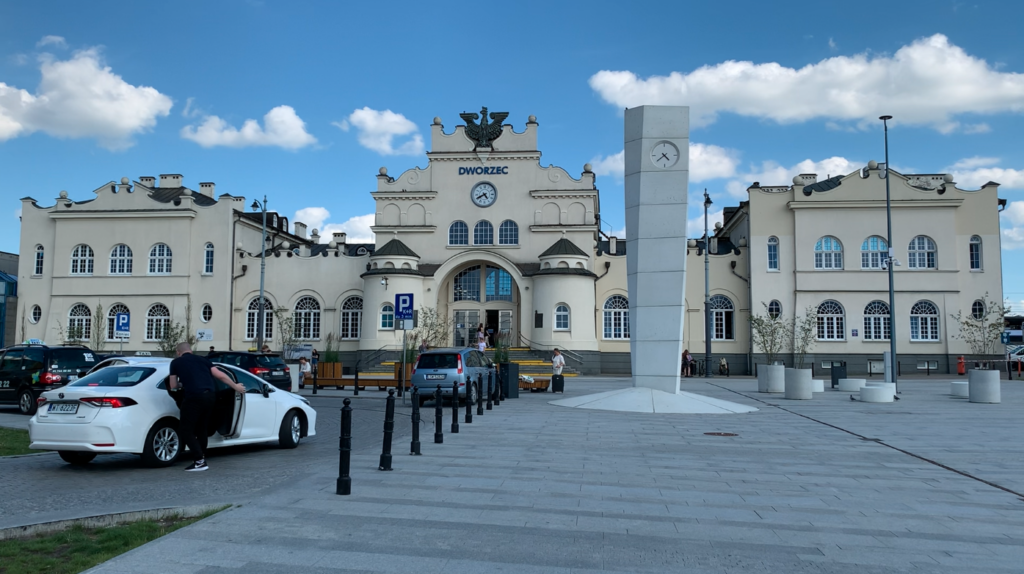
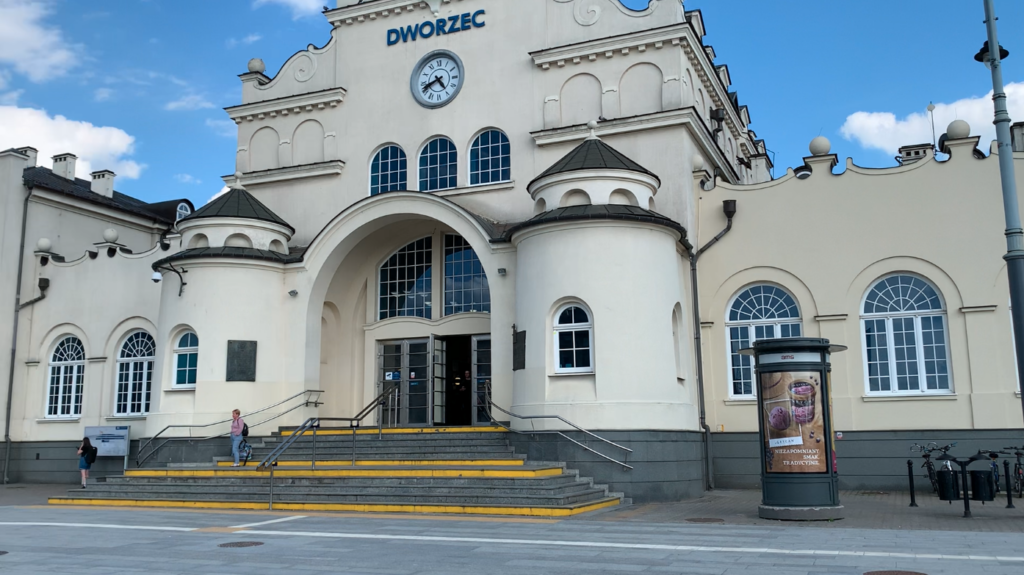
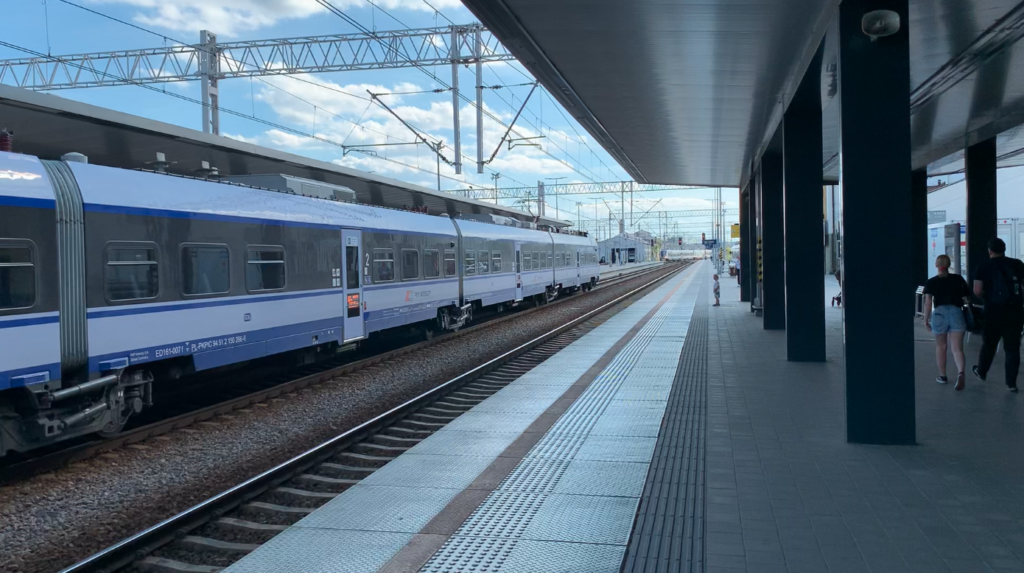
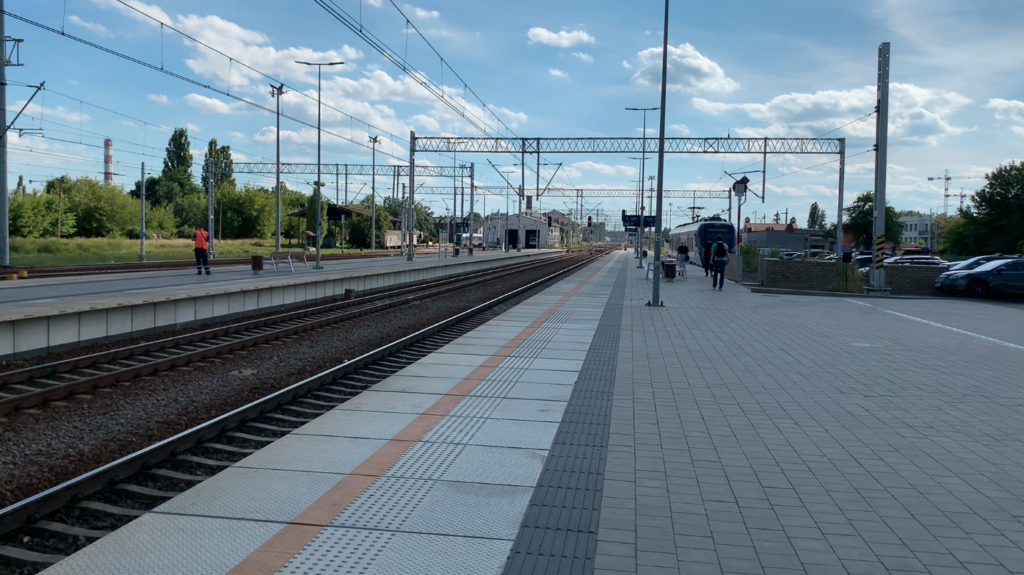
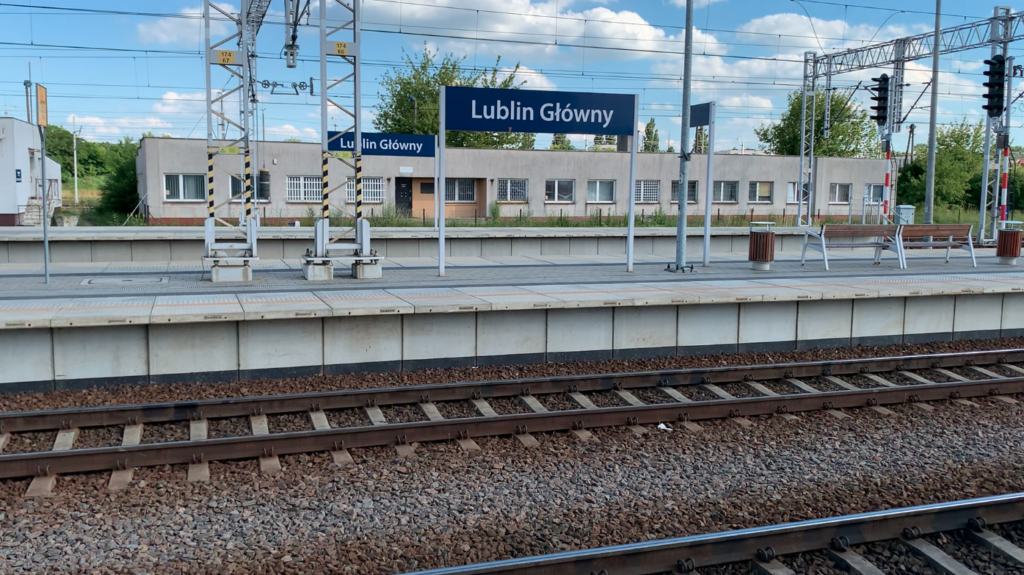
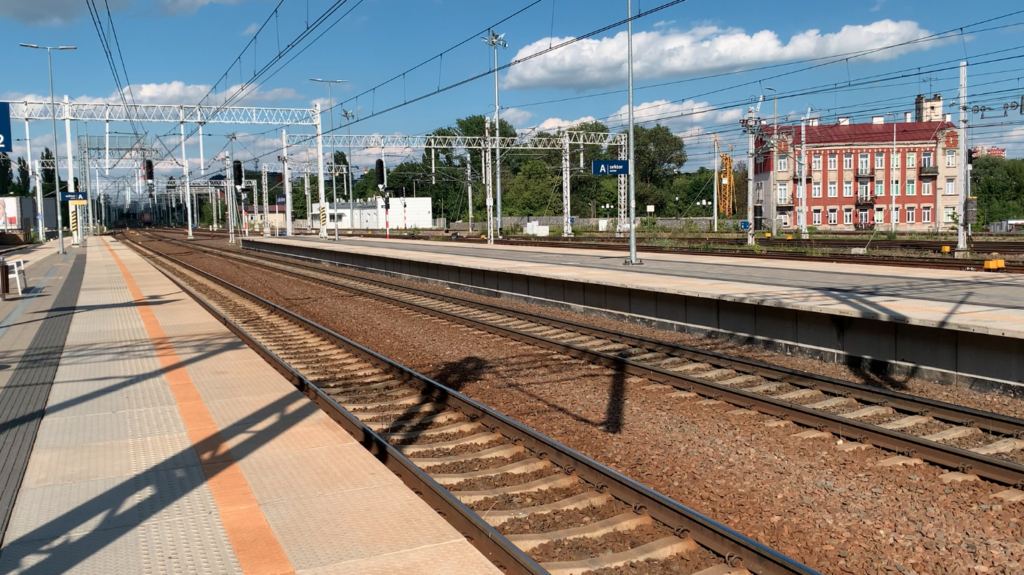
Tunnel under the tracks of Bychawska Street, currently Władysław Kunicki Street.
When the railway station in Lublin was opened, the railway tracks crossed Bychawska Street, now Władysław Kunicki Street, which leads to the towns of Frampol and Biłgoraj. It is one of the main streets of Lublin, passing through the Tenth district. Before World War II, it was called Bychawska Street. After World War II, the name was changed, and the new patron of the street was Władysław Kunicki (born June 12, 1872, died January 5, 1941) – a teacher, local government activist, PPS politician and owner of a junior high school in Lublin, a freemason.
Increasing road, pedestrian and rail traffic made the crossing more and more dangerous. There were several tracks that had to be crossed. There were many accidents, often fatal. Therefore, the crossing was commonly called the “Death Crossing”. The first attempt to build a viaduct took place when the railway line towards Chełm was built in the 1890s. The first project was started only in 1911. In 1915, excavations began. However, the ongoing great world war interrupted these works. What’s more, the excavations that had already been made were backfilled. Apparently for military reasons. The documentation was destroyed because the plans were never found.
The project of building a tunnel under the tracks was returned to in Reborn Poland in 1925. The project was commissioned to Paszkowski, Próchnicki i S-ka. The facility was accepted on October 2, 1928. From then on, the Tenth District was called “Beyond the Tunnel.” However, the tunnel was not without its drawbacks, as it was often flooded with rainwater. Over time, this problem was dealt with. There were 6 tracks running above the tunnel. The length of the tunnel was 83 m. The total width was 26 m. The tunnel consists of two spans. The tunnel spans are built on 32 double columns in the Doric style.
Platforms.
Platform 1 has been significantly extended towards the east (towards Chełm). This part of the platform is intended for trains that leave for the airport and Lubartów. Platform 1A and Platform 1B have tracks with retaining trestles. Platform 1 serves trains on track No. 52, which is a through track. The track serves long-distance trains from the east; Kiev, Zamość, Chełm, and trains from Warsaw. Due to the length of the platform, long trains stop here. Platform 1A is next to track No. 82 with a retaining trestle. It is the western part of Platform 1. This platform serves trains from/to Lublin towards Dęblin and Warsaw. Platform 1B is located at track No. 54 and adjacent to Platform 1. In history, it was the platform of the Polish Post Office. The platform serves trains towards the east and to Lublin Airport.
Platform 2 is an island platform. Access to the platform is provided by a tunnel for passengers. The platform mainly serves long-distance traffic.
Platform 3 is an island platform. Due to its shorter length, it serves mainly regional trains to the station; Dęblin, Stalowa Wola, Rzeszów and Chełm. After a long break, from December 2023, the station serves trains to Łuków.
The new platforms at Lublin Główny station are higher, making it easier to get on and off trains. New shelters have been installed, which are wider and longer than the previous ones. There are new benches and garbage bins. New lighting ensures safe access to the carriages even after dark. People with limited mobility have access to the platforms thanks to elevators. There are guide paths and warning lines with buttons for blind and visually impaired people. The display cases contain information and timetables. A major deficiency on the platforms is the lack of a Dynamic Passenger Information System. The system did not exist in 2024.
Lublin Główny Station 2024.
At the Lublin Główny station there is a fan locomotive shed with 27 stations. The turntable is operational. Throughout its history, the locomotive depot operated steam locomotives (until 1988). Mainly steam locomotives of the Pt47, Ty2 and Ol49 series and diesel locomotives, mainly of the SU45, SU46, ST43, SM42 series, were stationed in Lublin. Currently (2024) the locomotive shed is not used. Two inactive water cranes are a souvenir of the steam locomotives. There are many holding tracks at the station for passenger trains with wagons. The station also operates the PKP Energy Section and the Measurement Laboratory. There is also a rectangular, two-station locomotive shed at the station. The locomotive depot belongs to the PolRegio Maintenance Section, which mainly serves EMU and DMU trains.
Next to the rectangular locomotive shed there is a monument of technology in the form of the Pt47-157 steam locomotive, which was installed in 1987. The Pt47-157 steam locomotive was manufactured at the Hipolit Cegielski Metal Industry Plant in Poznań in 1950, with the factory number 1415. The vehicle began service on July 15, 1950, in Szczecin. The steam locomotive was removed from the inventory on March 10, 1987, in Lublin. There is also a chapel nearby; Saint Catherine of Alexandria.
Lublin Główny station is equipped with light semaphores, which were installed in 1968. Traffic at the station was directed through three signal boxes: LbA (western head), LbB and LbC (on the eastern side of the station). A new Local Control Center was built near the eastern head of the station. LCS launched in 2023. The center also operates stations; Northern Lublin, Motycz, Sadurki and Nałęczów. Freight traffic in Lublin is handled mainly by the Lublin Tatary station.
Commemorative plaques; On the occasion of the 1st anniversary of taking control of the railway by Lublin railway workers (1919). On the occasion of the 1st anniversary of organizing the first DOKP in post-war Poland (1945). Commemorating the railway workers of the Lublin junction who were victims of the fight against the Germans (1966). On the occasion of the 10th anniversary of “Lublin July 80”. (1990). Commemorating the help of Lublin railway workers for children from the Zamość region (1995).
Lublin railway routes.
Railway line No. 7 Warszawa Wschodnia – Dorohusk, this is the former Vistula Railway. In Poland, it is 267.471 km long. The line is double-tracked along its entire length (except for the section from Wólka Okopska to the border with Ukraine) and fully electrified.
Railway line No. 67 is a line connecting Lublin Główny station with Świdnik station. It is electrified along its entire length. This railway line was opened on July 17, 1877, as part of the Vistula Railway. On November 8, 1968, the railway line was electrified on the Lublin Główny – Lublin Tatary section, and in 1981, to Świdnik.
Railway line No. 68 Lublin Główny – Przeworsk is a railway line with a length of 177.512 km, which runs from north to south. The line is electrified with a voltage of 3 kV DC.
Railway routes leave from the Lublin Główny station in the directions; Warsaw East through Nałęczów, Puławy Miasto and Dęblin. In Dęblin there is a branch towards the Radom Główny, Skarżysko Kamienna, Kielce stations through Pionki. There is a departure towards Przeworsk through Lublin Zemborzyce, Niedrzwica, Wilkołazy, Kraśnik, Rzeczyca, Zaklików, Stalowa Wola Rozwadów and Leżajsk. There is an exit towards the border with Ukraine; Dorohusk border crossing through Lublin Północny, Świdnik, Rejowiec, Chełm. In Jaszczów there is a branch to Zawadów and Puchaczów (the route to the Lubelski Węgiel Bogdanka company). In Rejowiec, a branch to Zawada, from where it runs towards Zamość and Hrubieszów to the border crossing in Hrebenne through Zawada, Szczebrzeszyn, Zwierzyniec. In Chełm there is a branch to Włodawa. Direction Świdnik through the Lublin Tatary freight station. Direction Łuków through Lubartów, Parczew, Radzyń Podlaski. Passenger train traffic to Łuków was restored on December 10, 2023.
In June 2024, 78 trains departed from Lublin Główny station per day. You could get to the following stations: Biała Podlaska, Bohumin, Bydgoszcz Główna, Chełm, Dęblin, Gliwice, Gorzów Wielkopolski, Hrubieszów Miasto, Jagodin, Katowice, Kołobrzeg, Kraków Główny, Kraśnik, Lublin Airport, Łódź Fabryczna, Łuków, Parczew Kolejowa, Poznań Główny , Rzeszów Główny, Stalowa Wola Południe, Stalowa Wola Rozwadów, Szastarka, Szczecin Główny, Świnoujście, Terespol, Warszawa Wschodnia, Warszawa Zachodnia, Wrocław Główny, Zamość Wschód, Zielona Góra Główna.
Written by Karol Placha Hetman
